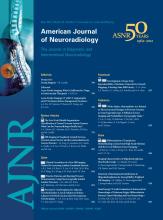Abstract
BACKGROUND AND PURPOSE: The carotid bulb is innervated by the sinus nerve of Hering, a branch of the glossopharyngeal nerve, derived from the third pharyngeal arch. The aim of this study was to determine the frequency, predictors, and outcome of the carotid BR after carotid stent placement according to the location of the plaque lesion.
MATERIALS AND METHODS: Atherosclerotic carotid plaques of apical versus body lesions were prospectively analyzed in 95 consecutive patients who underwent carotid stent placement. Patients with hypertension after stent placement were excluded, and transient (<3 hours) and prolonged (3–24 hours) BR, together with AEs such as strokes and death, were assessed in the 2 lesion locations (apical versus body). Other factors known to affect the carotid baroreceptor were also investigated, and the results were analyzed by χ2 or Mann-Whitney U tests.
RESULTS: Transient BR occurred in 30% of apical lesions in contrast to 70% of body lesions (P = .001). Transient BR showed a significant relationship to lesion location (P = .001), occurring most frequently in body lesions, and to the distance of maximum stenosis from the ICA ostium (P = .001). Hyperperfusion and AE rates (P = .076) in 1 month occurred more frequently in apical lesions.
CONCLUSIONS: The frequency of transient BR after carotid stent placement was lower in the apical region of the carotid bulb. Different cardiovascular disturbances after carotid stent placement can be attributed to anatomically different areas of the carotid bulb.
ABBREVIATIONS:
- AE
- adverse event
- BP
- blood pressure
- BR
- baroreceptor reaction
- CCA
- common carotid artery
- CEA
- carotid endarterectomy
- mRS
- modified Rankin Scale
- NIHSS
- National Institutes of Health Stroke Scale
- NTS
- nucleus tractus solitarii
- SBP
- systolic blood pressure
- © 2012 by American Journal of Neuroradiology
Indicates open access to non-subscribers at www.ajnr.org












